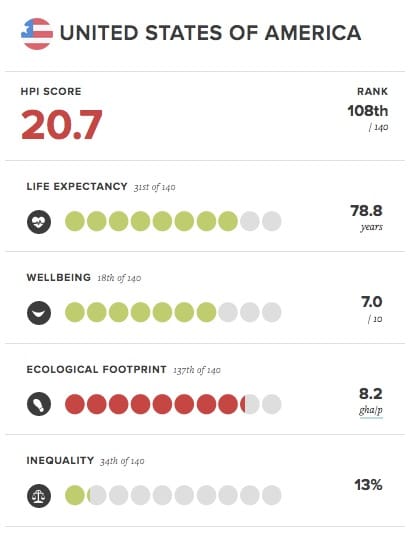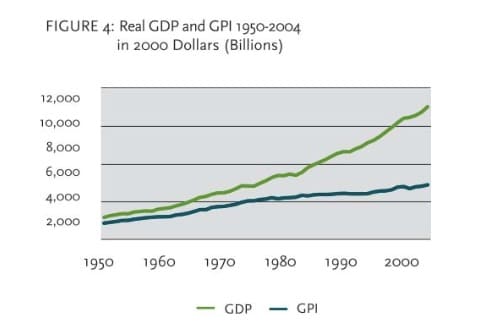We can live lives that are beautiful, rich, connected, and sustainable. They can be sustainable for ourselves, our families, our communities, and the planet. We know how to do this…now. We have never had greater knowledge of historical successes and failures, greater technological help, greater resources, or broader access to different modern models for how people are achieving sustainable well-being. And, there has never been a more important time to use those gifts to transition to lives of sustainable well-being.
The New Economic Foundation measures sustainable well-being with the sustainable well-being index (officially they also call it the Happy Planet Index because they told me it sounded better, but I prefer the other name):

Well-being (the numerator) is defined as how healthy we are, how happy we are, and how long we live. But, it’s also important how many resources we use to achieve that well-being (the denominator). If we get our happiness by abusing children, that’s not ok. Similarly, if we achieve our well-being by taking more than our fair share of resources thereby reducing the possibility that our children will have a chance at well-being, that’s also not ok. Thus, the sustainable well-being index is an efficiency measure. Similar to miles per gallon, it tells us how much well-being we have per resource used. How are we doing?
In America, we rank #31 for life expectancy, and #18 for

Though we rank #31 for life expectancy, and #18 for well-being, we use 4.5 planets’ worth of resources to achieve our well-being (2007 EF data, published in 2010). This means that we rank #137 (out of 140 countries) in the world for sustainable well-being (see this New Economic Foundation Report, 2012). Furthermore, we distribute those resources very unequally (the top 20% get nearly 85% of them), an unfair distribution that a recent study has shown most people do not agree with (see this post).
Another approach to measuring the success of our lifestyles is The Genuine Progress Indicator from Redefining Progress. The figure demonstrates that

while GDP goes up, genuine progress lags behind. Part of the reason is that there are very negative things that are nonetheless good for GDP: murder and divorce are two examples. When someone gets divorced, they normally hire two lawyers, sell their house, and buy two new houses, all of which are good for GDP. There are also very positive things that do not get counted in GDP: parenting and caring for a sick family member are two examples.
The signs that our current lives are unsustainable are increasingly obvious. Regardless of whether you agree with all the signs that our way of life must change, there are always enough signs left over to convince most of us: from salinization, the reemergence of infectious disease, economic fragility, soil erosion, economic hardship & fragility, species extinction, climate change, the end of cheap energy, and half a dozen other signs o’ the times. Again, you don’t have to believe them all: any 5 or 6 are probably sufficient to convincingly demonstrate the need for our culture to transition to one of sustainable well-being.
